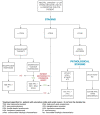Management of Low Rectal Cancer Complicating Ulcerative Colitis: Proposal of a Treatment Algorithm
- PMID: 34068058
- PMCID: PMC8152518
- DOI: 10.3390/cancers13102350
Management of Low Rectal Cancer Complicating Ulcerative Colitis: Proposal of a Treatment Algorithm
Abstract
Low rectal Carcinoma arising at the background of Ulcerative Colitis poses significant management challenges to the clinicians. The complex decision-making requires discussion at the multidisciplinary team meeting. The published literature is scarce, and there are significant variations in the management of such patients. We reviewed treatment protocols and operative strategies; with the aim of providing a practical framework for the management of low rectal cancer complicating UC. A practical treatment algorithm is proposed.
Keywords: inflammatory bowel diseases; rectal cancer; surgical management; treatment algorithm; ulcerative colitis.
Conflict of interest statement
The authors declare no conflict of interest.
Figures






References
-
- Selinger C.P., Andrews J.M., Titman A., Norton I., Jones D.B., McDonald C., Barr G., Selby W., Leong R.W. Long-term Follow-up Reveals Low Incidence of Colorectal Cancer, but Frequent Need for Resection, Among Australian Patients with Inflammatory Bowel Disease. Clin. Gastroenterol. Hepatol. 2014;12:644–650. doi: 10.1016/j.cgh.2013.05.017. - DOI - PubMed
-
- OCEBM Levels of Evidence Working Group. [(accessed on 9 January 2021)];2011 Available online: https://www.cebm.ox.ac.uk/resources/levels-of-evidence/ocebm-levels-of-e....
LinkOut - more resources
Full Text Sources

